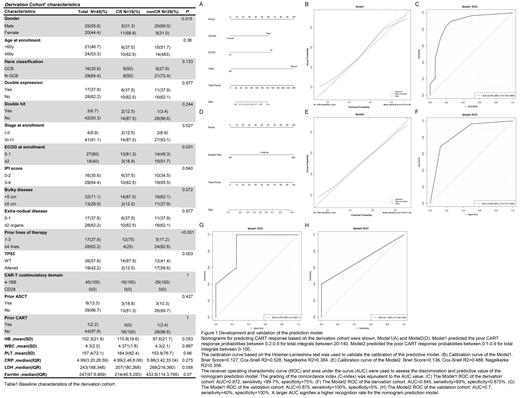Currently, Autologous CD19 chimeric antigen receptor T-cell therapy (CART) has become the most important treatment modality for relapsed or refractory diffuse large B-cell lymphoma (r/r DLBCL) beyond conventional multi-line treatments. However, it is worth noting that over 60% of CD19 CAR-T recipients will eventually experience relapse. A substantial amount of clinical research has been conducted to explore the reasons for the ineffectiveness or relapse of CAR-T therapy. Based on a comprehensive analysis of clinical data, we selected various combinations of predictive factors and used the TRIPOD guidelines to construct a logistic regression model for predicting the efficacy of CD19 CAR-T therapy.
This study was conducted as a retrospective cohort study, including patients with confirmed diagnosis of DLBCL who underwent CD19 CAR-T therapy and met the following criteria: (1) aged 18 years or older but not exceeding 80 years; (2) voluntarily participated in the study and signed an informed consent form. The exclusion criteria for this study were: (1) addition of other chemotherapy drugs or targeted drugs within 90 days before assessing the best response after infusion, except for those who achieved complete response (CR) or progressive disease (PD); (2) death caused by non-tumor progression factors within 90 days after infusion.
After the inclusion and exclusion criteria, a total of 54 patients with DLBCL undergoing CD19 CART at Shanghai Tongji Hospital of Tongji University ultimately participated in this study from January 1, 2019, to April 31, 2023. The derivation cohort consisted of 45 patients enrolled in clinical trials (NCT02537977, NCT03154775, CTR20201986, CTR20200561). The median age of the patients in the derivation cohort was 60 years (IQR: 50-67 years). Out of the 45 participants, 25 (55.6%) were male, and 29 (64.4%) had the non-germinal center B-cell (non-GCB) subtype, 1 had grade 3-4 Cytokine Release Syndrome (CRS). The validation cohort consisted of 9 patients involved in real-world studies. The median age of the patients in the validation cohort was 55 years (IQR: 52.5-69 years). Out of the 9 participants, 5 (55.6%) were male, and 6 (66.7%) had the non-GCB subtype, 2 had grade 3-4 CRS. The demographic and clinical characteristics of the derivation cohort were similar to those of the validation cohort.
Based on the best CD19 CART response at 90 days, we divided the derivation cohort into two groups, CR and non-CR. Then, we selected a series of candidate predictive factors from baseline data such as clinical features, genetic features, and laboratory features before CART (Table 1). The results of univariate and multivariate logistic regression analysis were used to select specific factors (Gender, ECOG, TP53) as model prediction indicators based on p-values (p<0.05). There was no significant correlation between these factors (p>0.1). A score nomogram (Model1) was plotted using the regression coefficients of each predictive factor as weights (Fig.1 A), C-index (Model1) =0.872 (Fig.1 C). To facilitate better clinical use, we also constructed a risk nomogram (Model2) to assess the degree of risk (Fig.1 D). Model2 considers three factors: Male, ECOG≥2, TP53 altered. If a person has not any of these risk factors, they are categorized as low risk. If there is one risk factor present, they are deemed to be at moderate risk, whereas having two or more risk factors classifies them as high risk. C-index (Model2) =0.845 (Fig.1 F). Finally, the model's clinical efficacy was validated using real-world CART-treated patients, and the C-index was calculated as Model1=0.875 (Fig.1 G), Model2=0.7 (Fig.1 H), confirming the clinical impact of the model.
In conclusion, this study has successfully developed an easily implementable clinical prediction model. For the first time, we have used CART clinical studies as the derivation cohort and real-world results as the validation cohort. Our scoring system provides clinicians with accurate and objective efficacy information, helping them identify the appropriate population for CAR-T therapy in DLBCL.
Disclosures
No relevant conflicts of interest to declare.


This feature is available to Subscribers Only
Sign In or Create an Account Close Modal